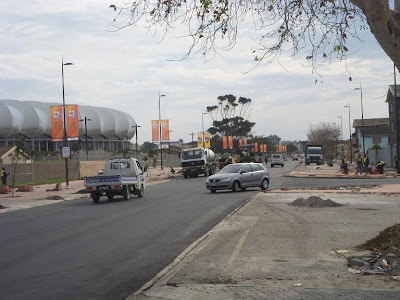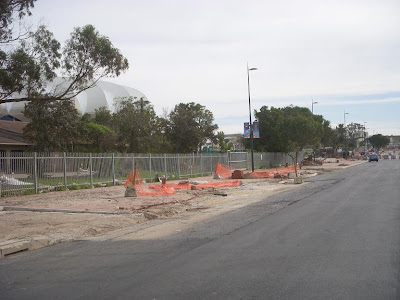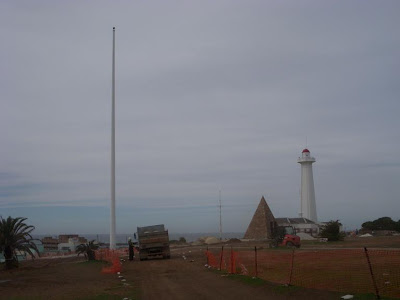More paving work under way near the Alfred Road entrance.
The stadium prides itself in its "green" achievements as far as recycling of waste is concerned. Also, indigenous trees and shrubs are being used, such as these outside the Alfred Road entrance, ready for planting.
Also on the Milner Avenue side, massive rolls of cables can be seen outside what we assume is the temporary media centre next to the stadium.
A scaffolding walkway has been installed between the media centre (green and white on right, partly obscured by container) and the stadium. The media's seats in the stand are not far from where the scaffolding joins the building.
More containers (grey, right) have been placed on the paving on the Milner Avenue side, while temporary fencing has been extended.
The paving process has gone overboard at the Milner Avenue entrance, where they have taken the paving right across the road. Somebody has secured a nice sub-contract for all this work. It just makes you wonder how it is going to be maintained in the long term, given how run-down parts of the city have been allowed to become in recent months. Hopefully the municipality will pull out all the stops before the world arrives on our doorstep.
The softening effect of a bit of grass. Since we last visited, large areas have been grassed (another nice contract). This is also on the Milner Avenue side, with the large tree on the right the one that once housed a carpet in its branches, part of which we still spotted on a lower branch. Higher up they seem to have installed a wooden "nest" for the raptors (hawks, I think) they are using to combat any meddlesome vermin. And here we're not talking about football hooligans!
More green, green grass has been planted on the Fettes Road side.
Also on the Fettes Road side, what we think is a practice pitch is still to be grassed, though the entire surrounds are now softly green.
At the Fettes Road entrance, a final area between walkway and tarred parking area is being readied either for grass or, hopefully not, more brick paving.
The big area of concern is whether roadworks further afield, like this at the corner of Fettes Road and Harrower Road, will be completed in time. The situation is also bad near the airport.
Talking of the airport, when we were there last weekend (40 days to go on the countdown clock), we espied this large temporary prefabricated arrivals terminal which has been erected next to the permanent one. They are expecting something like four times the normal passenger traffic ahead of big games, especially the first-round match between England and Slovenia on June 23.
The new temporary arrivals terminal.
With the new temporary terminal in the distance, something of the 2010 World Cup spirit has been created with the installation of these posters at the main arrivals terminal. Inside the concourse we found a great curio shop selling Cup memorabilia.
It just shot up! This new hotel next to the airport is all but complete, a welcome new addition to the city's growing accommodation infrastructure.
This 45-metre tall flag pole has just been erected on the Donkin Reserve as part of its upgrade. Whether it will detract badly from the iconic 1820 Donkin Pyramid remains to be seen once the refurbishment of the area is completed. A lot of work is still to be done in just a month.
There is a flurry of activity on the site, which is far, far from ready.
Plenty work afoot. It was a Saturday when we visited, and workers were hard at it on the Donkin. The new flag pole can be seen on the left. The plan is to hoist a 12m by 8m national flag there at a ceremony towards the end of the month by when, presumably, work must be complete.
A disgrace. Across Whites Road from the Donkin Reserve is this eyesore. The historic Grand Hotel is a rundown mess, though the owners do say they intend restoring it to its former glory. The sooner the better.
Soccer City. This huge advert has been placed over part of Newspaper House in Baakens Street. A mock-up of the Johannesburg Sunday Times, the nation's biggest newspaper, it features a photograph of Soccer City, venue for the opening match and the final. The 19th century old Post Office building on the left is another disgrace, left by its owner to fall into ruin. While part of the roof is being repaired, this has been done at the loss of an ornate chimney and ventilation feature.
Work is under way at King's Beach where the unsightly old Smartie Train and paddling pool have been removed and the area is being grassed, which will provide a great place to kick a soccer ball around.
Historic features are part of what gives a city its character. Sadly, in recent years Port Elizabeth's council has been pretty rudderless in this regard, as key buildings fall into disrepair. This feature on the esplanade near Humewood Beach commemorates the Memorable Order of Tin Hats, or MOTHS, which like a lot of the esplanade is looking terribly shoddy.
Just a bit further up Beach Road, however, a new City Lodge hotel has shot up in the past few months, although it won't be ready by June 11 - but you never know ...
Nearly 20 years ago the Brooks Pavilion went up on a site which for generations was a caravan site with one of the best views in the country. It fell into disrepair, but is now being gutted and refurbished and will house restaurants again in the future.
This budding Ronaldo was spotted keeping a ball up on a tatty stretch of land next to the Shark Rock pier at Hobie Beach. The area was used for the Splash Fetival over Easter, but no attempt seems to have been made to get the grass growing again on all the bald patches. Just not good enough!
Bayworld, previously the Oceanarium, was once the pride of Port Elizabeth. The leaping dolphin sculpture on the right is a trifle redundant given that the last two dolphins were shipped across to Hong Kong several months back. The facility still does house other sea mammals rescued in Algoa Bay, as well as large fish tanks, a snake park and the Museum.
Port Elizabeth's Stonehenge. These monoliths rising from the sheltered Indian Ocean at Humewood Beach are not quite as old as their British counterparts and are in fact the remnants of a whaling station slipway.
Peaceful place. And this, dear blog followers, is an empty bench overlooking Humewood Beach (note the remains of the metal slipway, which is linked to the monoliths). After all the World Cup drama, this is a great stretch of coastline on which to enjoy the quiet of the seashore.
 Brick paving galore characterises the main entrance to the stadium in Alfred Road, which saw final preparations yesterday ahead of Sepp Blatter's visit.
Brick paving galore characterises the main entrance to the stadium in Alfred Road, which saw final preparations yesterday ahead of Sepp Blatter's visit. This area was a dusty wasteland last time we visited. Now it has been grassed and looks a lot cooler.
This area was a dusty wasteland last time we visited. Now it has been grassed and looks a lot cooler. A view of the Milner Avenue entrance, which shows there are still some ugly areas to be patched up. We also noticed that lights have been installed along the length of Milner Avenue and up Gibaud Road, with a new walkway on the northern side of the lake nearing completion and the road being widened. Should be ready by June 13, when the first match is held in Port Elizabeth.
A view of the Milner Avenue entrance, which shows there are still some ugly areas to be patched up. We also noticed that lights have been installed along the length of Milner Avenue and up Gibaud Road, with a new walkway on the northern side of the lake nearing completion and the road being widened. Should be ready by June 13, when the first match is held in Port Elizabeth. Further afield, we took a look at the St George's Park cricket stadium, scene for the city's Fan Park - and found this poster with a plan of the ground dating back to the 2003 ICC World Cup. There was, in fact, no visible sign, outside the stadium, of preparations for the fan park.
Further afield, we took a look at the St George's Park cricket stadium, scene for the city's Fan Park - and found this poster with a plan of the ground dating back to the 2003 ICC World Cup. There was, in fact, no visible sign, outside the stadium, of preparations for the fan park.+-+Copy.JPG) Nice view. When Sir Rufane Donkin named the tiny village below him Port Elizabeth, after his late wife, in 1820, he stood on an area he proclaimed public open space in perpetuity. The Donkin Reserve is being upgraded, and this statue is one of 67 art works being installed on a Mandela Walk - or "Route 67" - named after his 67 years of public service. This will lead from the 1923 Campanile (marking the British Settlers' arrival in 1820) and across the Donkin.
Nice view. When Sir Rufane Donkin named the tiny village below him Port Elizabeth, after his late wife, in 1820, he stood on an area he proclaimed public open space in perpetuity. The Donkin Reserve is being upgraded, and this statue is one of 67 art works being installed on a Mandela Walk - or "Route 67" - named after his 67 years of public service. This will lead from the 1923 Campanile (marking the British Settlers' arrival in 1820) and across the Donkin.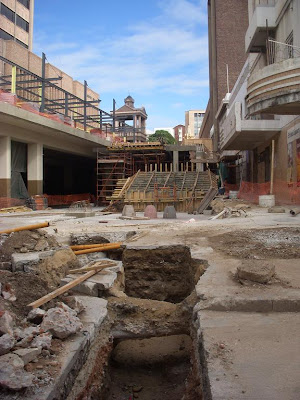 A road, Jetty Street, once ran along here, next to the Market Square. It was subsequently covered to form a bus terminus, with the Campanile Hotel on the right suffering as a result. Now they have removed some of that concrete and are building a showpiece staircase linking Strand Street to the Market Square.
A road, Jetty Street, once ran along here, next to the Market Square. It was subsequently covered to form a bus terminus, with the Campanile Hotel on the right suffering as a result. Now they have removed some of that concrete and are building a showpiece staircase linking Strand Street to the Market Square.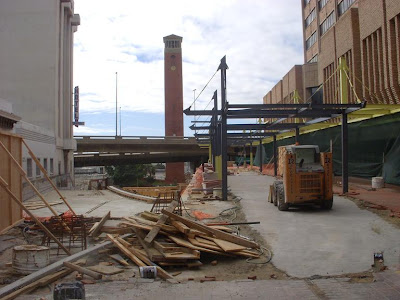

.JPG)








